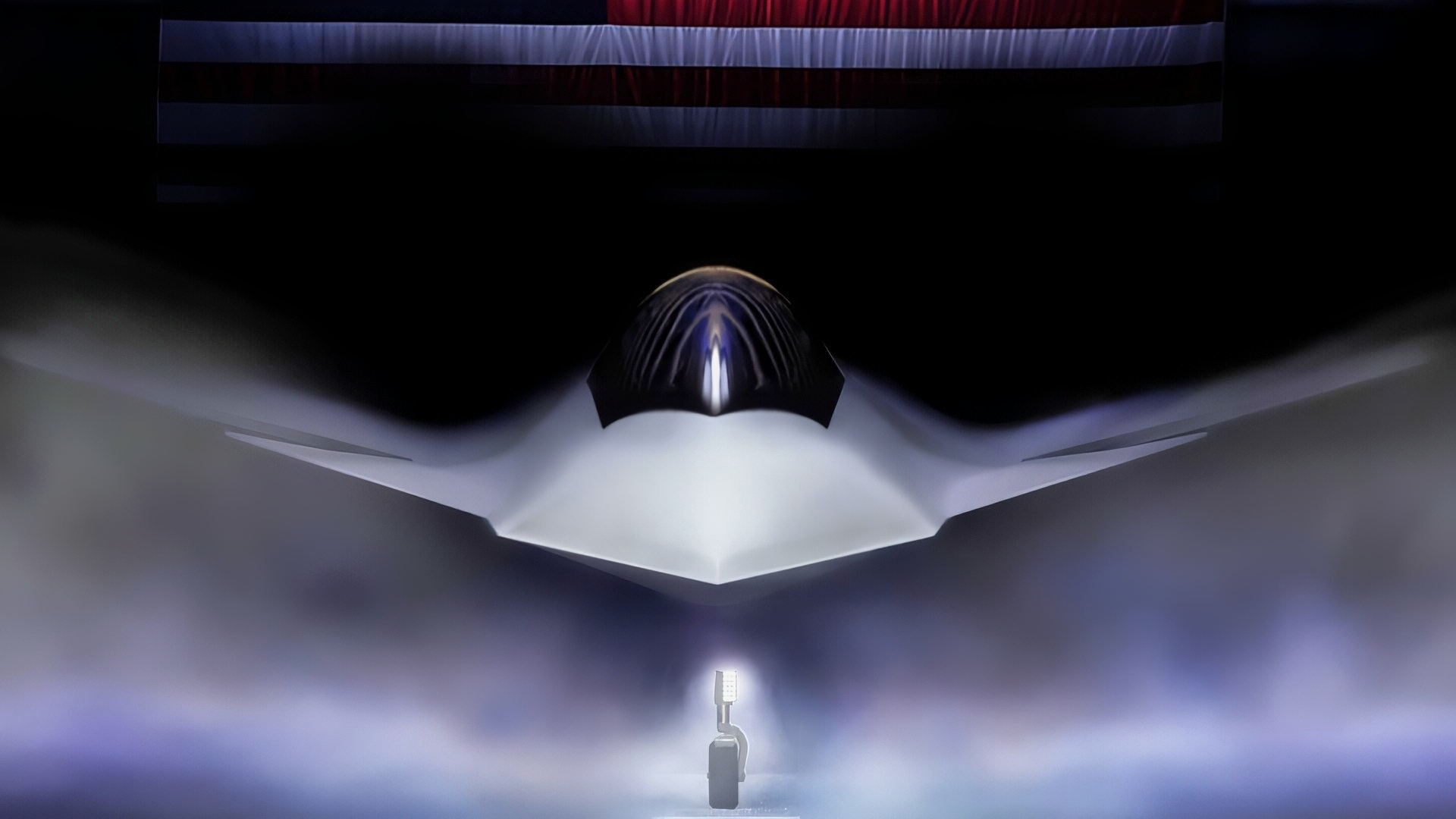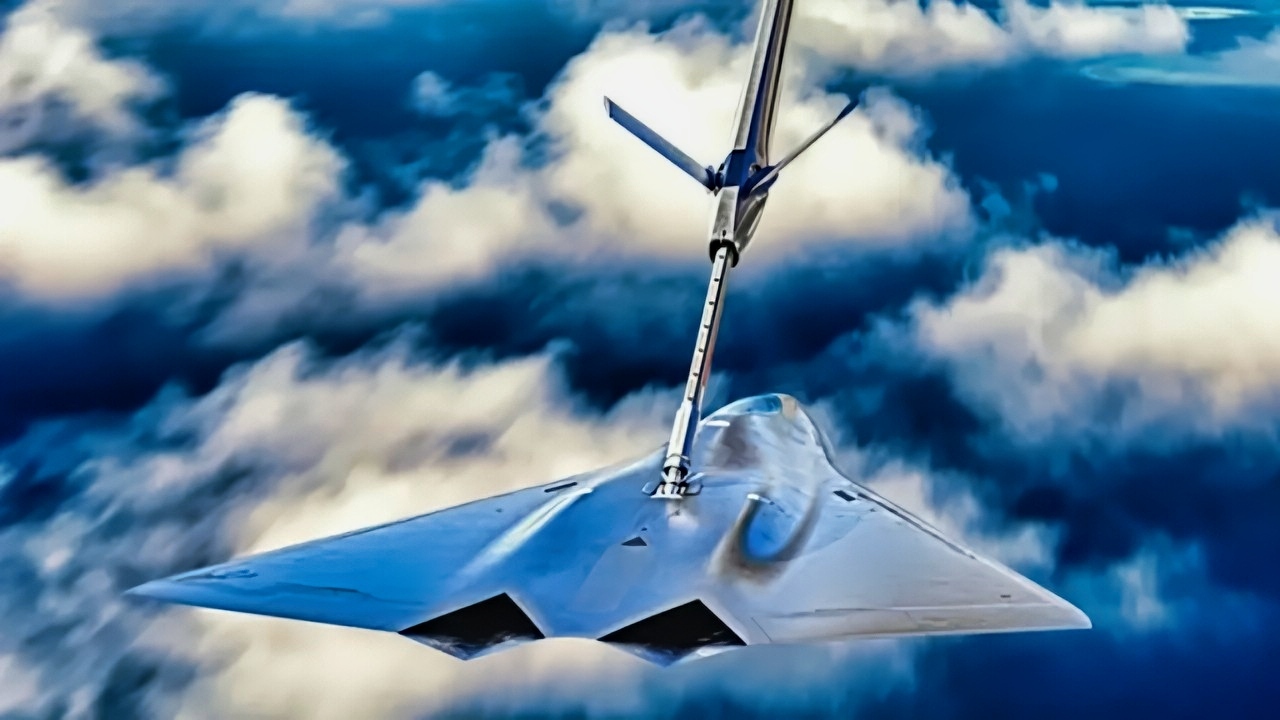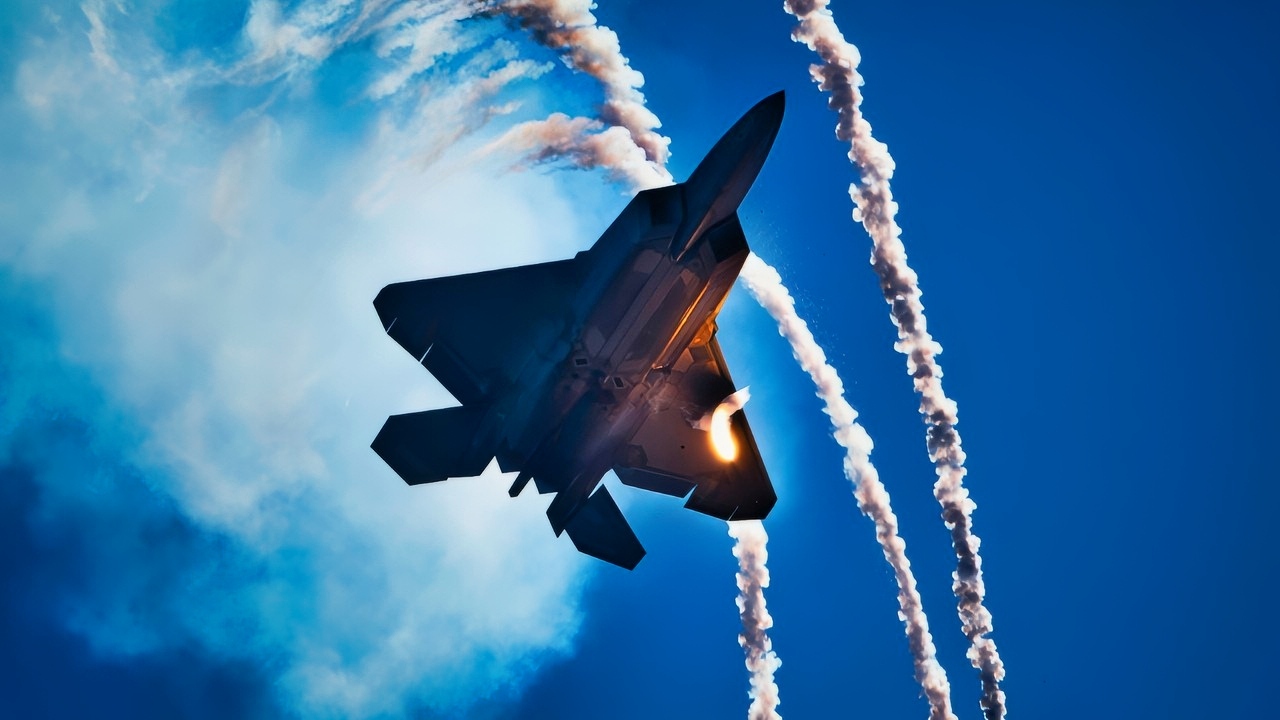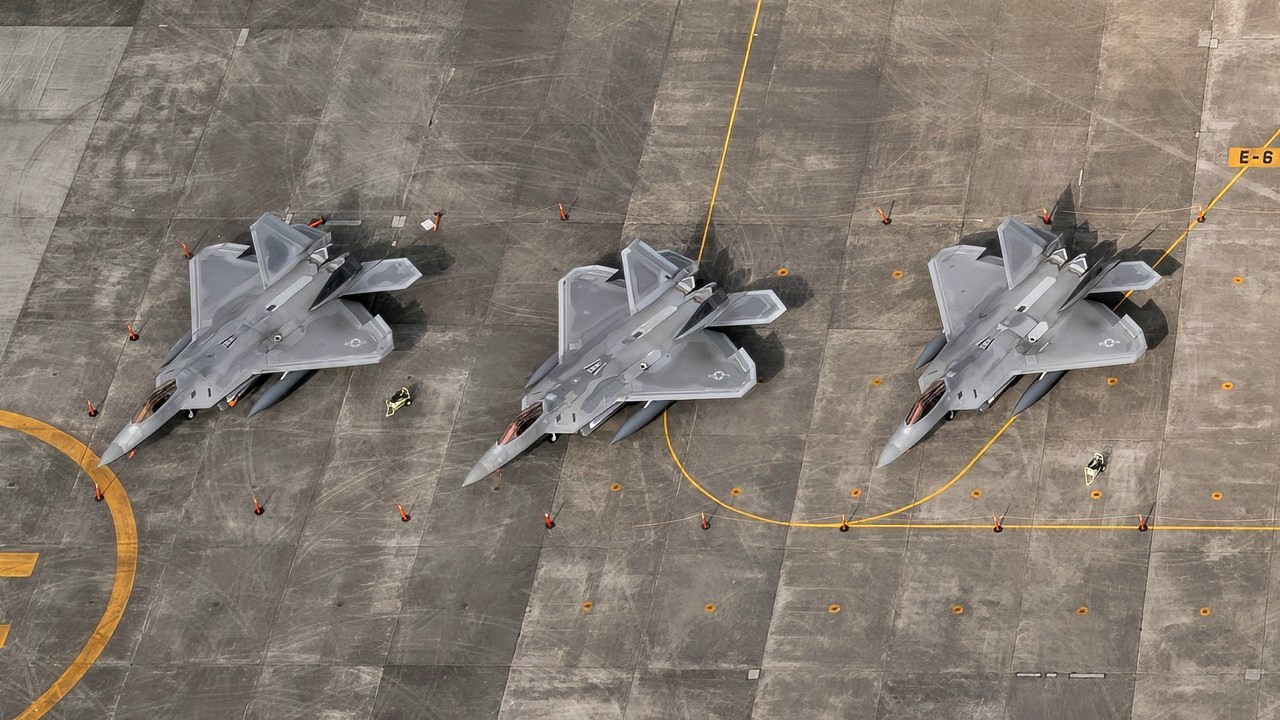Key Points and Summary – Without the F-47, the U.S. Air Force Risks Losing the Next Air War
– The F-22 Raptor is still the most lethal air-superiority fighter flying, but it is a 1990s design flying into a 2030s threat environment. China is churning out J-20 stealth fighters, experimenting with its own sixth-generation designs, and building an air force meant to deny the United States any safe sanctuary over the Western Pacific. The Air Force’s new Boeing F-47, centerpiece of the Next Generation Air Dominance (NGAD) program, is not a luxury add-on.

Shown is a graphical artist rendering of the Next Generation Air Dominance (NGAD) Platform. The rendering highlights the Air Force’s sixth generation fighter, the F-47. The NGAD Platform will bring lethal, next-generation technologies to ensure air superiority for the Joint Force in any conflict. (U.S. Air Force graphic)

F-47 Lockheed Photo. Image Credit: Lockheed Handout.
-The F-47 NGAD is the only realistic way to replace an aging, tiny F-22 fleet and claw back air superiority in an era of massed stealth, long-range missiles, and swarming uncrewed systems.
Why We Need the F-47 NGAD
Here’s an idea: Picture the Western Pacific in the early 2030s.
On one side, a few squadrons of exquisitely capable but aging F-22 Raptors, pushed to the edge of their range, tethered to vulnerable tankers, trying to hold a line over thousands of miles of ocean.
On the other side, wave after wave of Chinese stealth aircraft, long-range missiles, and uncrewed systems pouring out of the mainland and from a growing network of island bases.
That is no longer a hypothetical the Air Force can ignore. It is the environment that the service itself now plans against. And in that world, the F-22 is no longer enough — not in numbers, not in range, and not in raw survivability.
The F-47 NGAD fighter is the answer to that problem. Not because it is shiny and new, but because the alternative is slowly losing the sky.
As one former U.S. Air Force general told me last week: “If we don’t build a lot of F-47 fighters, we will lose the next air war. That is a fact you can surely take to the bank.”
The F-22 Was Built for a Different War
The F-22 was born out of the Advanced Tactical Fighter program, a late–Cold War bid to ensure American dominance over Soviet fighters.

Boeing X-32 National Security Journal Photo. Taken on 7/19/2025.
It first flew in the 1990s and entered service in the 2000s — a triumph of stealth, supercruise, and sensor fusion at the time. But the program was cut at just under 200 operational jets.
That decision locked the Air Force into a boutique fleet. For a while, that did not matter. There was no peer air threat, and Washington convinced itself that “good enough” would stay good enough.
Now the bill is coming due.

A U.S. Air Force F-22 Raptor, flown by Capt. Samuel “Razz” Larson, F-22 Raptor Demonstration Team pilot, deploys flares over the Gulf of Mexico during the 2024 Gulf Coast Salute Air Show at Panama City Beach, Florida, May 4. The F-22’s unique combination of stealth, speed, agility and situational awareness, combined with lethal long-range air-to-air and air-to-ground weaponry, makes it one of the most advanced fighters in the world. (U.S. Air Force photo by Staff Sgt. Stefan Alvarez)
Many F-22s have already been in service for over two decades. The Air Force is pouring money into upgrades — new sensors, networking, electronic warfare, and range-extending tanks — but leaders increasingly describe the jet as a “bridge” to NGAD, not the final answer.
That is the point: you can bolt new pods on a Raptor. You cannot bolt on another 400 miles of unrefueled range or magically turn a fleet of fewer than 200 jets into 400.
The aircraft was also designed for an era when the United States assumed it would own the tanker tracks and operate relatively close to friendly bases. Its combat radius forces it to lean on refueling aircraft that are themselves juicy targets for long-range Chinese missiles.
You can keep overwriting the F-22’s software. You cannot overwrite geography.
China Is Flooding the Pacific With Stealth
While Washington argued about fighter line items, Beijing went to work.
China’s J-20 “Mighty Dragon” is no longer an exotic prototype. It is entering service in meaningful numbers, with production accelerating and the aircraft evolving from one batch to the next. At the same time, China is pushing upgrades across its 4th-generation fleet, modernizing older designs with new radars, weapons, and data links.
Widen the aperture, and the picture gets worse. Beijing now fields a fighter force that is both larger and, on average, younger than America’s, with the share of modern 4th- and 5th-generation platforms rising each year. It is not a perfect mirror of the U.S. Air Force — far from it — but the days when American pilots could assume outright qualitative dominance are fading.
The PLAAF is not stopping at the J-20. Chinese industry is experimenting with what appears to be sixth-generation technology: tailless, diamond-shaped stealth designs, new engine concepts, and tighter integration between crewed aircraft and drones. You do not roll those shapes out in public unless you are serious about building the next generation.

J-20 Fighter from Chinese PLAAF. Image Credit: Creative Commons.
In other words, China is building fifth-generation fighters at scale while probing the next technological leap to sixth-generation systems, including stealth bombers and advanced fighters.
Meanwhile, the U.S. Air Force’s fighter fleet has shrunk in size and grown in age. Pilots are flying fewer hours. Modernization programs have been delayed or truncated. The gap between what the force can do on paper and what it would need to do against China in the Western Pacific is growing.
You do not need to be a PLAAF planner to see where this trajectory goes. If the United States does nothing bold on air dominance, it wakes up one morning and realizes that the “Raptor era” ended without a successor ready.

J-20 Stealth Fighter in China. Image Credit: PLAAF.
Enter the F-47: A Fighter Built for the China Problem
The F-47 NGAD is meant to be that successor. As one Air Force pilot explained to me last week in a more extended interview: “The F-47 is going to be built for a China war, and it’s a war that Beijing is gearing up to fight and win.”
This is not a marginal upgrade to the F-22. On paper and in early descriptions, the F-47 is a different animal.
It is designed with a far greater combat radius — measured in four digits, not three — specifically to operate from bases pushed back by China’s missile threat. It is built to survive in a dense, multi-spectral sensor environment where overlapping radars, passive detection systems, and electronic warfare systems all operate. It is expected to supercruise faster and farther than current fighters while carrying meaningful internal weapons loads.
And, crucially, it is being engineered from day one with open-architecture avionics and a digital backbone. That sounds like buzzword soup, but it matters. It means the jet is supposed to take on new sensors and weapons in months or a few years, not wait for decade-long “block” upgrades that show up half a generation late.
Those are not “nice to haves.” They are direct responses to the China problem.
To get shots off inside China’s anti-access bubble, you either bring the tankers closer — and risk losing them — or you build a fighter that can get in and out on its own legs. The F-47’s range is an explicit attempt to break that tanker dependence.
To survive in an era of overlapping Chinese radars, passive sensors, and electronic warfare, you do not just want marginally lower radar cross-section. You want a jet that is designed from day one to operate in a contested, multi-domain sensor web.
That is the NGAD design brief.
A Quarterback, Not a Lone Wolf
If all the F-47 did were replace the F-22 one-for-one, it would not be worth the price tag. The Air Force knows that. So the F-47 is being built as the quarterback of a “family of systems,” not as a lone wolf.

Eight U.S. Air Force F-22 Raptors from Joint Base Elmendorf-Richardson, Alaska, sit on the flightline, July 9, 2018, at Yokota Air Base, Japan. Eight F-22s evacuated from Kadena Air Base, Japan due to Typhoon Maria. The F-22 are deployed under U.S. PACOM’s theater security package (TSP) program, which has been in operation since 2004. (U.S. Air Force photo by Yasuo Osakabe)
At the core of that family are Collaborative Combat Aircraft — lower-cost, uncrewed jets designed to fly alongside the F-47, taking on some of the riskiest missions: scouting deep into enemy airspace, drawing fire, jamming, or carrying extra missiles.
That matters for two reasons.
First, it is how you square the circle between capability and mass. You will never field thousands of F-47s — but you can field hundreds of attritable uncrewed aircraft that extend the lethality of each crewed jet.
Second, it recognizes that air dominance is no longer a single-platform game. In a fight with China, the jet that wins is the one that sees farther, fuses more data, and orchestrates more effects — across manned and unmanned players — faster than the other side.
The F-22 was designed as the ultimate knife fighter in the sky. The F-47 is being designed to be the quarterback of an entire aerial strike package, plugged into joint fires, space-based sensing, and a web of uncrewed teammates.
“It’s Too Expensive” Misses the Real Cost on F-47 NGAD
Critics point to the projected cost of NGAD and throw up their hands. Rough estimates put the price tag per F-47 airframe far above any current fighter, and the program has already absorbed billions of dollars in research and development.
Those are big numbers. There is no point pretending otherwise.
But “too expensive compared to what?” is the only serious question that matters.
Compared to simply extending the F-22 forever? That is not actually an option. The airframes will age out; the maintenance burden will skyrocket; and the jet’s basic design will struggle more and more in a world of longer-range missiles, better sensors, and proliferated drones.
Compared to betting everything on the F-35? The F-35 is a remarkable multirole aircraft, but it was never meant to be a one-for-one air-dominance replacement for the Raptor. Its range, weapons carriage, and optimization are different. You do not send a multirole workhorse to do a penetrating counter-air job against a peer.

A U.S. F-35A Lightning II departs after conducting aerial refueling with a KC-10 Extender from the 908th Expeditionary Air Refueling Squadron, June 11, 2019 at an undisclosed location. The fifth generation fighter provides the pilot with comprehensive situational awareness in a sphere around the aircraft for missile and aircraft warnings, day and night vision, extended range detection and precision targeting against air and ground threats, granting the U.S. Air Force and its allies’ air superiority. (U.S. Air Force photo by Staff Sgt. Keifer Bowes)
Compared to doing nothing and hoping China’s modernization slows down on its own? That is not strategy. That is wishful thinking.
The uncomfortable truth is that air dominance against a near-peer in the 2030s was always going to be expensive. The real cost question is whether you want to spend money on an aging fleet that cannot get to the fight or on a new architecture that can.
Numbers, Timelines, and the Window of Risk
Even under optimistic assumptions, the F-47 is not rolling off production lines tomorrow. The Air Force is looking at the 2030s for the first operational jets and talks about a fleet measured in the low hundreds, not the thousands.
That creates a dangerous window.
Between now and then, China will almost certainly grow its J-20 fleet well beyond today’s numbers, push more 4th-generation jets through deep modernization, and continue experimenting with sixth-generation designs. If some projections are correct, Beijing could be adding stealth fighters at a pace that dwarfs anything the United States has seen since the early Cold War.
The only way to narrow that window is to treat NGAD and its F-47 core not as a “nice to have someday” but as a crash priority now. That means protecting funding from the usual budget knife fights. It means keeping the digital design and open architecture on track so the jet does not show up obsolete. And it means accelerating complementary pieces like uncrewed aircraft and long-range weapons, so that when the F-47 arrives, it plugs into a kill web that already exists.
The good news, if there is any, is that this is increasingly how the Air Force talks about the program. The bad news is that talk has to survive election cycles, budget cliffs, and competing priorities.
We Need the F-47 NGAD Now
The F-22 Raptor gave the United States two decades during which no adversary could seriously contest it in the air. That era is ending — not because the Raptor suddenly became a bad jet, but because time, numbers, and China’s modernization curve are catching up.
The F-47 NGAD fighter is how the Air Force proposes to stay ahead. It is designed for the ranges, sensor densities, and missile salvos of a Chinese war, not the Soviet scenarios that birthed the Raptor. It is meant to lead a team of uncrewed aircraft, not fly alone. And it is being built, from day one, with a “built to adapt” mindset that the F-22 simply never had.
Yes, it will be expensive. Yes, there will be program turbulence, industrial headaches, and inevitable political fights.
But the alternative is worse: a 2030s Air Force flying museum-piece fighters, trying to bluff a peer adversary that has spent the last decade building the very stealth mass and range America chose to defer.
If the United States wants to keep the sky — especially over the Western Pacific — the F-47 is not optional. It is the buy-in cost to sit at the table in the next era of air war.
As a retired senior Department of Defense offical told me pretty bluntly: “The F-47 is no ‘Mission Impossible’ task. We need it; we can build it in large numbers at a solid price when we consider what we are getting. Now is the time to move forward.” Hard to argue against that.
About the Author: Harry J. Kazianis
Harry J. Kazianis (@Grecianformula) is Editor-In-Chief and President of National Security Journal. He was the former Senior Director of National Security Affairs at the Center for the National Interest (CFTNI), a foreign policy think tank founded by Richard Nixon based in Washington, DC. Harry has over a decade of experience in think tanks and national security publishing. His ideas have been published in the NY Times, The Washington Post, The Wall Street Journal, CNN, and many other outlets worldwide. He has held positions at CSIS, the Heritage Foundation, the University of Nottingham, and several other institutions related to national security research and studies. He is the former Executive Editor of the National Interest and the Diplomat. He holds a Master’s degree focusing on international affairs from Harvard University.
More Military
The Mach 2.2 YF-23 Black Widow II Stealth Fighter Has a Message for the U.S. Air Force
Mach 10 Missile Showers: China’s Aircraft Carriers Have 1 Big Advantage over the U.S. Navy
China’s New H-20 Stealth Bomber Keeps U.S. Air Force Generals Up at Night
The A-6 Intruder Has a Message for the U.S. Navy
How NATO Got Its Hands on Russia’s ‘Black Hole’ Kilo-Class Submarine










